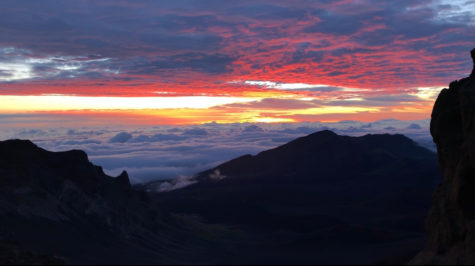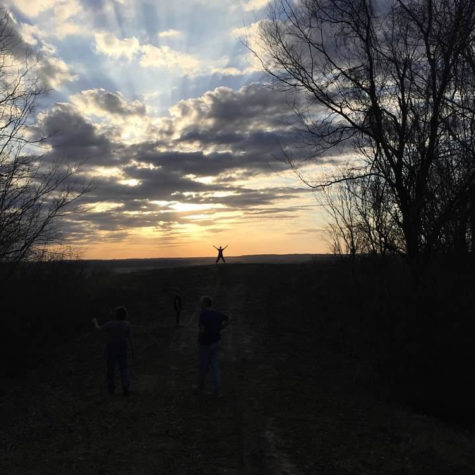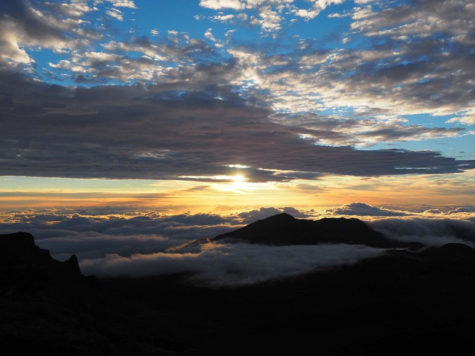It’s Getting Hot in Here
Student and staff discuss climate change.

With snow flurries in Los Angeles and melting ice caps at the North Pole, around the globe it appears the climate is changing. Everyone has a different opinion on the definition of climate change. Some call it a natural occurrence that will be solved on its own, while others call for action to fix it. The difference in opinions is causing disagreements that have spilled into students’ minds.
“To me, climate change is erratic and we may see more sudden changes in weather patterns due to the planet becoming warmer,” science teacher and Environmental club sponsor Rick Knowles said. “As we stayed home from school the other day, I read that March 4, 2019, was the coldest day on record for March. We will see more drastic changes to patterns of weather in the future, some warmer winters, some colder, droughts, floods, et cetera. They will be less predictable.”
Climate change may be seen as a theory that many refute, but the effects can be seen and are scientifically proven.
On October 7, 2018 on National Geographic, Stephen Leahy released
“Climate Change Impacts Worse than Expected, Global Report Warns.” The article summarized the past decade of record-breaking storms including storms, forest fires, droughts, coral bleaching, heat waves and floods. All of these were caused by an increased global temperature by 1.8 degrees Fahrenheit. The same report speaks about how a subtle change in temperature may not be noticeable in a room but is definitely noticeable on Earth and will cause permanent damage to ecosystems, humans, communities and economies.
“Climate change is erratic and we may see more sudden changes in weather patterns due to the planet becoming warmer. As we stayed home from school the other day,
I read that March 4, 2019, was the coldest day on record for March. We will see more drastic changes to patterns of weather in the future, some warmer winters, some colder, droughts and floods. They will be less predictable.”
Climate Change as a Conspiracy
Although the majority of LHS students think climate change is an important issue, with over 70 percent of poll responders stating that climate change is a “huge problem,” there are many students who either completely reject the idea of climate change or simply don’t believe it is an important topic.
When asked if they have made any lifestyle

changes to slow the effects of climate change, many students said they avoid making drastic changes to their diet or transportation habits because they don’t believe their individual actions matter in the grand scheme of things.
“I haven’t done anything in my life to change my carbon footprint because it would do little to nothing,” sophomore Jillian Arnold said. “Most of the media is focusing on climate change, but I don’t believe that it is really an emergency like people make it out to be.”
Students shared their thoughts that, while natural climate change occurs naturally on our planet, man-made climate change has a limited effect on the Earth or its rising temperature.
“If you look at Earth’s history over the past several million years, there have been instances due to the Earth’s axis not being balanced, where the planet undergoes drastic climate change,” senior Jimmy Freed said. “That’s why we had the ice age and warm periods of time. It can be seen through plant life, so obviously, climate change is a very real thing.”
Freed went on to explain where his skepticism lies in regards to carbon emissions and climate change.
“Man-made climate change, as well as carbon emissions, have never been proven to destroy the atmosphere,” Freed said. “It’s just a relatively new thing with the wave of liberalism in the 21st century. Obviously, pollution is a problem and we should all stop polluting. However, I don’t believe that climate change
can be reversed because it happens naturally throughout time. I feel like the mainstream media really pushes it as a problem because it is a rallying point for a lot of political parties.”
The Paris Agreement
The Paris Agreement is a contract between countries of the world joining them to work together to counter social, economical and global problems.
“The Paris Agreement sends a powerful signal to markets that now is the time
to invest in the low emission economy,” a statement from 2018 by the United Nations said. “It contains a transparency framework to build mutual trust and confidence.”
The agreement strives for an economy with a low carbon dioxide emission backed by a limited carbon power. This will help to minimize the output of greenhouse gases, specifically carbon dioxide, into the atmosphere.
The Paris Agreement aims to help the people of the world live better lives and to help act against global problems.
It is intended to fight against rising temperatures and the damages caused around the world.

In a National Geographic article, Stephen Leahy said, “Every country in the world agreed to keep global temperatures well below 3.6 degrees Fahrenheit (2 degrees Celsius), while low-lying island states and others lobbied for substantially less.”
Many believe the Paris Agreement is the right step toward a better future for the present and future generations.
“Most definitely, the U.S. should join the Paris Agreement,” Knowles said. “The U.S. should be a leader in the process and help shape what happens in the future. We should lead by example.”
Student Actions
The push to “Go Green” originated in
the 1970s after environmentalist Rachel Carson published her book, “Silent Spring,” which pushed environmental concerns into the public’s eye. As the effects of climate change have grown more dramatically in recent years, students have taken it upon themselves to go green in different aspects of their life.
Some of these students have been making environmental efforts for years, whereas others have started just recently.
“I volunteer at the Kansas City Zoo,” sophomore Laura Kallenbach said. “I’m called a VolunTeen. I started volunteering last summer. We strive to show the community how they can prevent environmental damages.”
Others practice environmentally healthy habits at home.
“We have three trash cans, which seems like a lot,” senior Maddie Boram said. “We have a red trash can for recycling, a black trash can for regular trash and we have compost which would be your banana peels and egg shells. We take our compost and we put it in a pile in our backyard. We let it sit and in the springtime, we put the compost in our garden for our new seeds we’ve planted. It really helps give the soil a boost after these Missouri winters and it’s less wasteful.”
Freshman Aiden Norris has brought down his family’s electric energy use.
“We replaced all of our lightbulbs in our home with LED light bulbs, which was my idea,” Norris said. “The LED light bulbs last longer and are more energy-efficient. They cost more to buy, but they are less than ten cents a year for your energy bill.”
Even the LHS cafeteria is more environmentally-conscious.
“The new smoothies in the cafeteria come in these cups that biodegrades by 92 percent in four years,” junior Audrey McBride. “Smoothie King switched to plastic cups recently and I think other companies could do the same and switch to a more sustainable option.” Starbucks, Ikea, Adobe and Nike are also companies going green by offering reducing their use of plastic that can’t be reused and reducing water waste with in some of the companies.
When asked why making changes to better the environment is important to them, most students had a similar answer.
“I think it’s time for all of us to stop looking at climate change as a conspiracy,” Kallenbach said. “It’s not something you choose to believe in or not believe in. We have the facts right in front of us and we can see the negative effects.”
Solutions
Combating climate change is not a personal feat.

“Climate change is not something we can solve with a quick fix,” science teacher Aaron Hohn said. “It’s going to take a substantial effort around the world to decrease carbon emissions, but it also provides a huge opportunity for research, development and economic growth, if leveraged properly.”
Climate change is a topic where there is no set solution quite yet, but researchers and scientists have found a way to help with the amount of carbon dioxide in the atmosphere. This is called reforestation, which is the act of planting more trees and vegetation with the intent to remove carbon dioxide.
Leahy stated in his report that when wood is made into furniture or buildings, carbon dioxide can be stored in them for a long time.
“Forests are carbon sinks, and the more vegetation you can plant, the more carbon dioxide they can remove from the atmosphere,” Knowles said. “The big issue is where you plant them. Habitat loss and destruction are continuing to rise, and it is a vicious cycle. The more trees lost, the more carbon dioxide is released.”
Climate and Land Use Alliance released a statement in 2017 where scientists discussed the benefits of reforestation. Forests pull moisture out of the ground and release the water vapor into the atmosphere, regulating local and global patterns precipitation. This acts as a natural air conditioner from the world.
“We are the only only generation who can see the effects of climate change and the only one who can do something about it,” Knowles said. “What will we say to our kids and grandkids when they ask, ‘Why didn’t you do something?’



